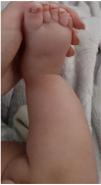We present the case of a male newborn aged 20 h in whom prenatal examinations had been normal and with a history of congenital oedema that had not been evaluated in first-degree relatives. At birth, he had respiratory distress that required non-invasive ventilation and swelling of the lower extremities. The physical examination revealed hard, cold oedema in both legs with thickening of the skin and ungual dysplasia (Fig. 1), in addition to hypoventilation in the base of the right lung.
A chest radiograph and computed tomography scan evinced right pulmonary hypoplasia (Fig. 2A), and a lymphoscintigraphy was requested due to suspicion of congenital lymphoedema, which confirmed the absence of lymphatic vessels in the lower extremities (Fig. 2B). The patient received a clinical diagnosis of type I congenital lymphoedema type I, or Milroy disease.
At present, at age 7 months, the patient is free of respiratory symptoms and in treatment with lower extremity compression and physical therapy, with a favourable response (Fig. 3). Genetic testing is underway.
Milroy disease is a rare condition with an estimated incidence of 1 case per 6000 live births with a 1:2.3 male-to-female ratio. It is caused by a variant in the VEGFR3 gene encoding the vascular endothelial growth factor receptor 3, resulting in aplasia or dysplasia of lymphatic vessels.1 It manifests as congenital progressive oedema in the lower extremities, in isolation or as part of a syndrome.2 Although it is infrequent and it is still unclear what it is associated with, the presence of congenital lymphoedema must prompt an investigation of the family history and a lymphatic and genetic evaluation.3 Appropriate multidisciplinary treatment may prevent progression to functional limitations, complications and sequelae. In selected cases refractory to conservative treatment, surgical treatment with vascularized lymph node transfer is a possible alternative that has achieved good results in recent case series.4
FundingThis research did not receive any external funding.
Conflicts of interestThe authors have no conflicts of interest to declare.












